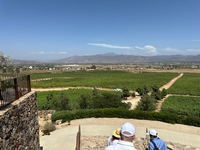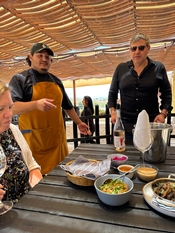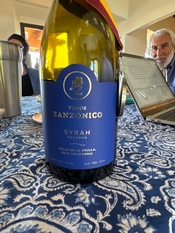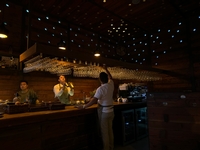One of the great things about wine is its ability to sensorially transport the consumer to a different place in the world. I’m sure you’d agree that the best wines do this, and while we often talk about wine in terms of regional typicity and whether – or not – a particular bottle achieves it, there’s nothing like going to a place and experiencing the wines in that place alongside the local cuisine to really cement what the area signature might be. I’ve lived in Southern California my entire life and just never seem to make it down, but a long-dreamed about trip with WRO editor Michael Franz to Valle de Guadalupe in Baja California, Mexico finally materialized just a couple of weeks ago. There’s plenty to report. Let’s jump in!
I hadn’t visited the area (located about 100 kilometers south of the US/Mexico border and just a few minutes east of the coastal city of Ensenada) for about 10 years, and to say that things have changed would be an understatement to say the least, with the winery count now pushing 300 – an exponential increase over what was present then.

A View of Valle de Guadalupe from Las Nubes Bodegas & Viñedos
Though the Valle de Guadalupe’s first winery, L.A. Cetto, was founded nearly one hundred years ago, it wasn’t quickly followed by others wanting to grow grapes and make wine. Winemakers I met with spoke of “the first wave” or second generation of wineries starting in the 1960’s with Domecq, mid-1980’s with names like Monte Xanic, continuing into the mid-1990’s with names like Camou and Adobe Guadalupe. In the 2000’s the floodgates started to open, with fine producers like Cava Maciel, Las Nubes, Corona del Valle, Casta de Vinos and Sierra Vita leading the charge.
The current scene is quite a patchwork of wine varieties, philosophies, and backgrounds. Over the course of five days, I met with long-time area residents, Mexican nationals from other states in Mexico, American expats, a son of Bordeaux’s Henri Lurton, and first, second and third generation producers that all have a unique spin on what the wine business can be in Mexico.
A few standouts: Michelle Martain of Cavas Valmar has a plan, with her sister, to restore the family Rancho (located within Ensenada’s city limits) to a working farm that will serve an educational purpose in addition to being a top flight wine and food destination; Jorge Maciel, who grew up in Ensenada and followed a passion ignited on a trip to Italy in 1993 and has a focus on showing what Mexican Chardonnay can be; Tru Miller, a Dutch-American expat who started Adobe Guadalupe in the center of the Valle after living an amazing life story that led her to the spot; Gerard Zanzonico, who spent forty years making wine in Napa Valley at Chateau Montelena, Stonegate, Staglin and Del Dotto and sought out the vibe that Napa had when he started there; and Dr. Arnufel Vasquez Fernandez, who works as an oral surgeon in Tijuana during the week, and as a third-generation farmer from Michoacan, makes wine at his Sierra Vita winery on the weekends adjacent to his sister and Chef Sandra Vasquez’ restaurant Once Pueblos (translated as “Eleven Towns”) that showcases authentic dishes from different regions across Mexico, with both enterprises focused on sustainability of the land and those who work it. (pro tip – the Pastel de Uchepo at Once Pueblos is not to be missed!)

Winemaker Jorge Maciel (r) and Chef Luciano Goncales
A couple of key observations: Winemakers are quick to point out that there are no rules about listing appellations when it comes to labeling wine in Mexico, and it’s common to see labels that say anything from “Product of Mexico” to “Baja California” to “Valle de Guadalupe,” though some intrepid producers have a keen eye on transparency when it comes to labeling, some calling out specifics in a way that the international market is used to seeing.
I was not aware that a good portion of the wine labeled as coming from Valle de Guadalupe can actually come from neighboring areas called Valle de San Vicente, Valle de Ojos Negros and Valle de Santo Tomas that are up to one hundred kilometers away. While a group of wineries is working toward establishing a system similar to the US’s AVA designations, they wisely do not want a set of accompanying regulations that will restrict what can be planted in particular locations (at least at this point). This makes good sense for an area that is still discovering what varieties do well in certain locations, which can take multiple vintages to discover.
Additionally, I didn’t notice much of what used to politely be called “regional signature salinity” in the wines that I tasted. Winemaking science and vineyard practices have clearly made major inroads in dealing with irrigation and aquifer issues that were thought to be the cause of the problem, allowing winemakers a wider set of expression options. More reviews of wines I tasted will be spread across future
WRO issues, but here’s a top-flight performer to whet your appetite:
Vinos Zanzonico, Valle de la Grulla (Baja California, Mexico) Syrah “Reserva” 2020 ($53): A beautiful, fruit-driven Syrah that winemaker Gerard Zanzonico says,

“pairs well with a hammock” may have you hanging one in your backyard after getting a taste. Grown in sandy, well-drained soils south of Ensenada, it shows bold black and blue fruit and a gentle savory note on the nose, leading to palate impressions in which savory character shows a little more, joining the fruit as a rich complement. Bright pepper suggestions arrive in the finish. This is inky, seductive and very long, with excellent balance and weight with no heaviness. Great stuff!
95
You may not have seen many wines from Mexico on menus or in shops in the US – this likely has to do with the current 46% tax rate imposed on wine exported. That provides yet another reason to plan a trip, in addition to the fine dining that awaits your visit. I had exceptional food at Kous Kous del Valle (yes, Moroccan food), Fauna (and it’s accompanying winery Bruma), and Deckman’s, an outdoor experience that’s a feast for the senses.

The Bar at Fauna
A few travel tips: Driving into Mexico was just like I remember it from forty years ago, save a brief (appx. 5 seconds) stop for a photo of the car. The toll road from Tijuana to Ensenada features just a few inexpensive tolls, has two lanes in each direction, is well maintained, and offers spectacular views of the Pacific, the Coronado Islands, Islas Todos Santos and Cabo Punta Banda. We stayed at a very nice Airbnb property centrally located in the Valle – feel free to contact me for a referral.
Returning across the border back to the US is easy if you are a CBP Trusted Traveler – there’s a Global Entry/Sentri lane that can literally save you hours if you are so equipped. If you’re a California resident, you can bring one liter of wine per person back with no tariffs, but if you’re from another state, you can bring multiple cases back.
Click back to WRO in the near future for more reviews as well as editor Michael Franz’s take on the area (it’s always great to get another perspective, whether it is contrasting or reinforcing). Finally, I hope all this spurs you to plan a visit to the region – if my experience is any indication, you won’t regret it. I know I’ll be going back…and sooner rather than later!